The Next Front in Palestine Solidarity: Worker Strikes
The symbiotic relationship between universities and the military puts higher education workers in a position of significant structural power.
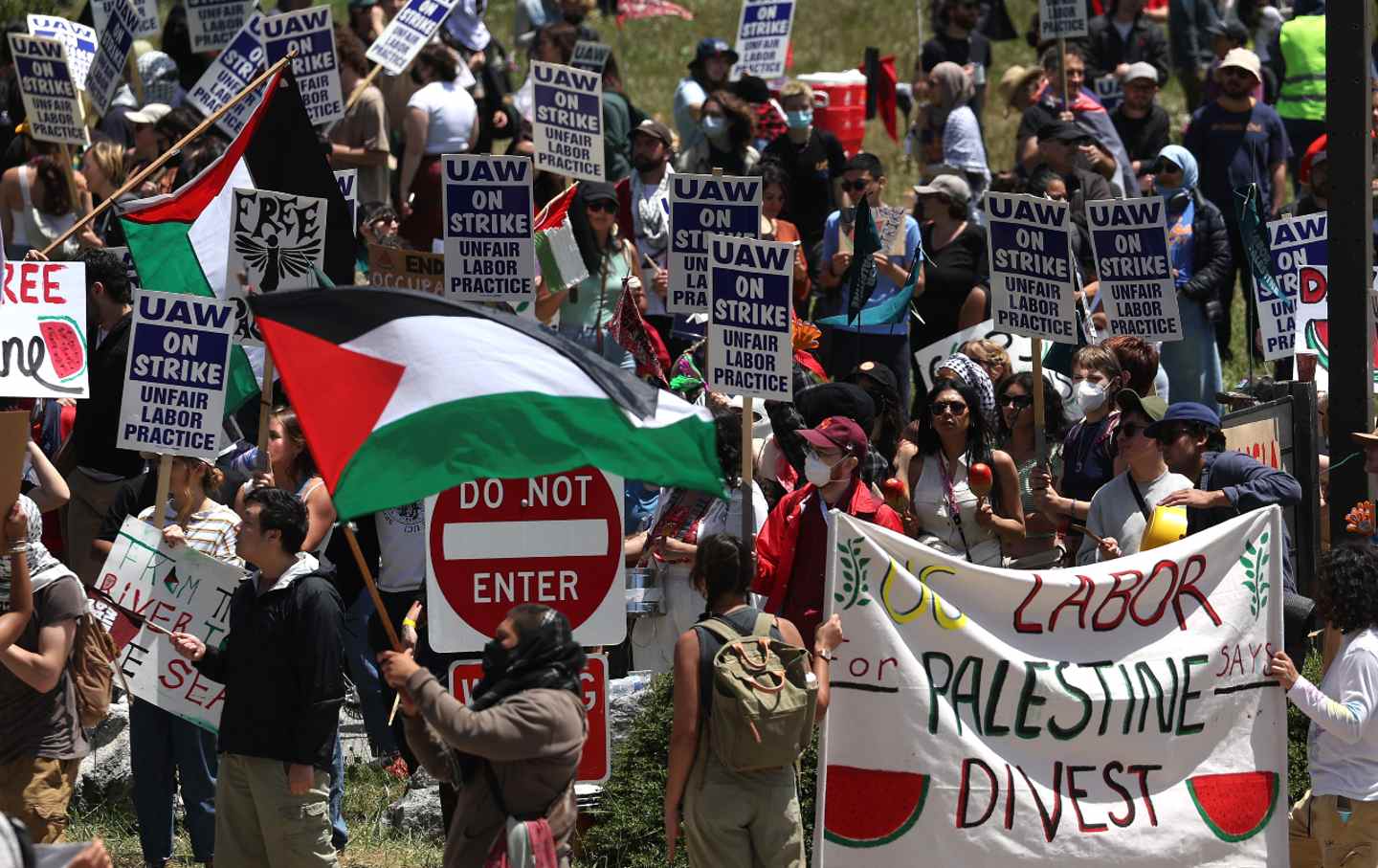
This spring’s university encampment protests represented a welcome step up in the Palestine solidarity movement. Now, as students leave campus for the summer, their activism is spawning a further escalation—one that holds tremendous promise for the US anti-war movement: worker strikes.
This week, 48,000 University of California (UC) workers—postdocs, graduate student researchers, and teaching assistants—began a rolling strike in response to the violent police crackdown on pro-Palestinian campus students and workers. On Monday, 3,000 union members at UC Santa Cruz walked out of classrooms and research laboratories and onto picket lines. Today, May 23, Union leaders announced that beginning next Tuesday, more than 10,000 workers at UCLA and UC Davis will begin to strike as well, and other workers in the 11-campus UC system will soon follow.
Mass anti-war street demonstrations seek to disrupt political discourse. But there are very few instances—at least in the United States—of workers wielding the strike weapon to disrupt the war economy. The UC strike could introduce a powerful new strategy to not just resist today’s US support for the Israeli war on the Palestinians but also challenge the US imperialist war machine in the years ahead.
Two factors will determine whether this new anti-war front succeeds: First, whether UC workers can persuade others to expand the strike strategy to more universities—and even other industries; and second, whether the workers can sustain strikes through the inevitable backlash, which will be particularly brutal precisely because opponents will properly see widespread strike action as a significant threat to their war plans.
The UC workers—members of UAW 4811—credit the student-led protests for inspiring their union to go on strike. Along with their peers across the country, UC students this spring began building encampments in solidarity with Palestine. The backlash from UC administrators mirrored the repression at Columbia University and elsewhere: mass, often violent arrests of students, graduate workers, and faculty at UC campuses in San Diego, Berkeley, Irvine, and most notoriously, in Los Angeles, where on April 30 police stood aside while a far-right mob attacked the peaceful encampment, shooting fireworks and pepper spray and beating pro-Palestinian students and workers with sticks. Just 24 hours later, as the protesters were recovering from the assault, police swept in and violently broke up the encampment, arresting 209 people.
“We watched our union siblings beaten by Zionist mobs while the university did nothing, at first,” said Jake Orbison, an English Department graduate student worker at UC Berkeley. Then, by “calling the cops to beat their students a second time,” the UC administration “politicized every UC campus,” Orbison said.
Last Wednesday, police from at least 23 different Orange County police departments assaulted the UC Irvine pro-Palestine encampment. They beat dozens of protesters, including History Department graduate student worker Mark Gradoni, who spent the night in jail alongside National Lawyers Guild legal observers, a journalist, faculty, and others who had been seized in the police riot. “It’s surreal to be at @UCIrvine, my workplace & intellectual home, to attend my friend’s dissertation defense and then be attacked, beaten, and jailed because members of our academic community hung a banner in the memory of the late [assassinated Palestinian human rights activist] Alex Odeh,” he tweeted the next day.
In the wake of the police crackdown, the UAW filed a series of unfair-labor-practice charges against the university, detailing how it violated the members’ legal and contractual rights when it attacked and arrested union members alongside others protesting peacefully.
The union demanded that the university provide amnesty for all protesting UC workers, students, and faculty; commit to the right to free speech and political expression on campus; divest from weapons manufacturers, military contractors, and companies profiting from Israel’s war on Gaza; disclose all funding sources and investments; and, most ambitiously, give research workers transitional funding to opt out of projects tied to the US military or oppression of Palestinians.
In a series of strike authorization votes last week, nearly 20,000 UAW 4811 members statewide voted 79-21 percent in favor of striking.
Contemporary strikes in America usually focus on the traditional union contract topics of “wages, hours, and working conditions.” In this strike, the UAW members are pointing out that police violence, the suppression of speech, and the university’s role in the war economy are integrally tied to working conditions; solidarity with Palestinians half a world away starts with defending your own rights at work.
“When we’re fighting for wages, it’s about who has access to the university. Right now, our fight is about our right to political speech and protest, which goes to the heart of our rights as workers,” said UAW 4811 President Rafael Jaime, a graduate worker in the UCLA English Department. Workers elsewhere should take note of this expansive understanding of union rights.
UC leaders were quick to call the action “illegal.” But the UAW members appear undeterred by these employer threats. As education workers in the #RedForEd movement of recent years know well, the go-to union-busting move for employers facing a powerful strike is to declare it outside the law. Indeed, the declaration of illegality by employers is simply proof of workers’ tremendous strike power.
Observers outside the university setting may be skeptical that graduate student workers and postdocs striking for Palestine will have much economic impact. What does the ivory tower have to do with the Pentagon or the Israeli assault on Gaza?
Quite a lot, as it turns out.
In 2021, the Department of Defense (DoD) gave a staggering $7.36 billion in research grants to 454 different colleges and universities. Last year, the University of California accepted $333 million from the DoD; the University of Texas at Austin, $191 million; the University of Southern California, $126 million; Columbia University, $49 million; Northeastern University, $33 million. These grants weren’t just for engineering programs and the hard sciences. Hundreds of millions of dollars in DoD grants went to math, psychology, and other social science departments. And those figures are likely a vast understatement of the war economy’s iron grip on higher education—they do not include grants from other federal agencies, outside of the Pentagon, that have military applications.
“People think about academic workers as somehow being removed from the supply chain of war production,” said Sarah Mason, a UC Santa Cruz graduate student worker. “The reality is that universities are a research arm of the defense industry. Millions and millions of dollars flow into laboratories on campuses across the UC, across the country. And this money is directly funding research that supports the war and occupation, not just in Palestine, but US imperialism around the world.”
Popular
“swipe left below to view more authors”Swipe →Much of this military grant money gets obscured in “dual-use research,” which Isabel Kain, a graduate student worker in the UC Santa Cruz Astronomy Department, described as “research that has an obviously weaponizable threat, but also could be put to positive use in society,” such as medical and biological research. In the past, Kain said, many university researchers avoided confronting basic questions about their role in the war economy: “My research is my research and what other people do with it is not my problem.”
But the Israeli mass killings of Palestinians and universities’ violent reaction to the anti-war movement have changed the calculus for thousands of UC scientists, Kain said. “The brutal police crackdown is the thing that’s pushing them over the edge to take collective action,” she said.
This symbiotic relationship between universities and the military puts higher-education workers in a position of significant structural power. A strike by university workers won’t have the immediate impact of, say, longshore workers blocking a weapons shipment. But over time, and enacted across many campuses, a university workers’ strike could challenge the imperial war machine.
“We have a unique opportunity—we are workers at an institution that hides its financial interests behind a veil of the pursuit of knowledge, while maintaining its position as a key node in the military industrial complex’s knowledge production,” said Tara Plath, a graduate student researcher in Film and Media Studies at UC Santa Barbara. “We have a role to expose and condemn how business is conducted at the UC, and how its bottom line is prioritized over the safety of academic workers and students alike.”
Two important developments in recent decades have made this strike moment possible. First is the changing composition of the university workforce. Fifty years ago, more than three-quarters of university faculty were tenure or tenure-track. Today, under the influence of increasing corporate control, universities have flipped those numbers: Some 75 percent of college classroom teachers are precariously employed as “adjuncts”—lecturers or graduate teaching assistants with no long-term job security. Laboratories, too, are dominated by graduate student workers and postdoctoral scholars. And increasingly, universities are turning to undergraduate workers to teach their peers, lead course sections, and do lab work.
The second development is that these workers—very highly trained, but just as precariously employed as Uber drivers or Amazon warehouse workers—did what comes natural to workers in exploitative circumstances: They banded together for self-defense.
In the last decade, more than 120,000 graduate and undergraduate workers across the US organized into unions, with more than 100,000 of those workers organizing in just the last three years, according to Joseph van der Naald at the City University of New York. Thousands more faculty—more than 8,200 last year alone—also formed unions during this period. In these new unions, workers have wasted little time in exercising their strike muscles. In the last year, there have been at least 18 higher education strikes, involving as many as 29,000 workers at a time, according to Cornell University’s Labor Action Tracker project. The UC workers now on a rolling strike know what it takes to run a picket line, having struck for six weeks in 2022.
None of this potential for worker strikes would have been possible during the last major anti-war upsurge, following the 2003 US-led invasion of Iraq. Veteran union organizer Gene Bruskin, one of the founders of US Labor Against the War, recalled the uphill battle just to get unions on record opposing the war. “We had to crank it out local by local, resolution by resolution, taking it into the national unions, organizing all the different entities to bring things to the floor. And that took months and months, and in some cases years,” he said.
Today, with university workers organized into unions, the opportunities are much greater. Yet none of the UC workers I spoke with in the last week seemed to be under any illusion about the scale of the challenge. They are going up against not just hostile university administrations but also big business leaders who are lobbying for severe crackdowns on the movement, a Biden White House that shamefully has denounced the protesters, and Israeli government leaders who are pledging to bring a new McCarthyism to US college campuses.
The student-led encampments have been organized admirably, but “organizing a strike is something of a different prospect,” said Jack Davies, a graduate worker at UC Santa Cruz. “A relatively small and coherent portion of the student body can drive a successful encampment and reach advanced positions on messaging, demands, platforms, etc. When you’re trying to organize a strike, you need a far broader commitment from the body of workers.”
Yet, Davies said, UAW 4811 members on the UC campuses seem determined to accept that challenge. “It’s crucial that we punch back right now, that we actually fight back, because workers across this country are getting the shit kicked out of them on this issue,” he said. “They’re getting fired, they’re getting arrested, even beaten. We’re seeing this in all kinds of sectors. And I think an example of a genuine fightback by organized labor in any sector is critical now, one that shows workers everywhere, in this moment, that the boss can’t have it all their way. What exactly is possible in our strike, and where it might lead in terms of winning real demands and setting precedents over disclosure, divestment, and transitional funding, is hard for anyone to say right now. I only know we have to hit back.”
Editor’s Note: This story has been updated to reflect recent developments.
More from The Nation
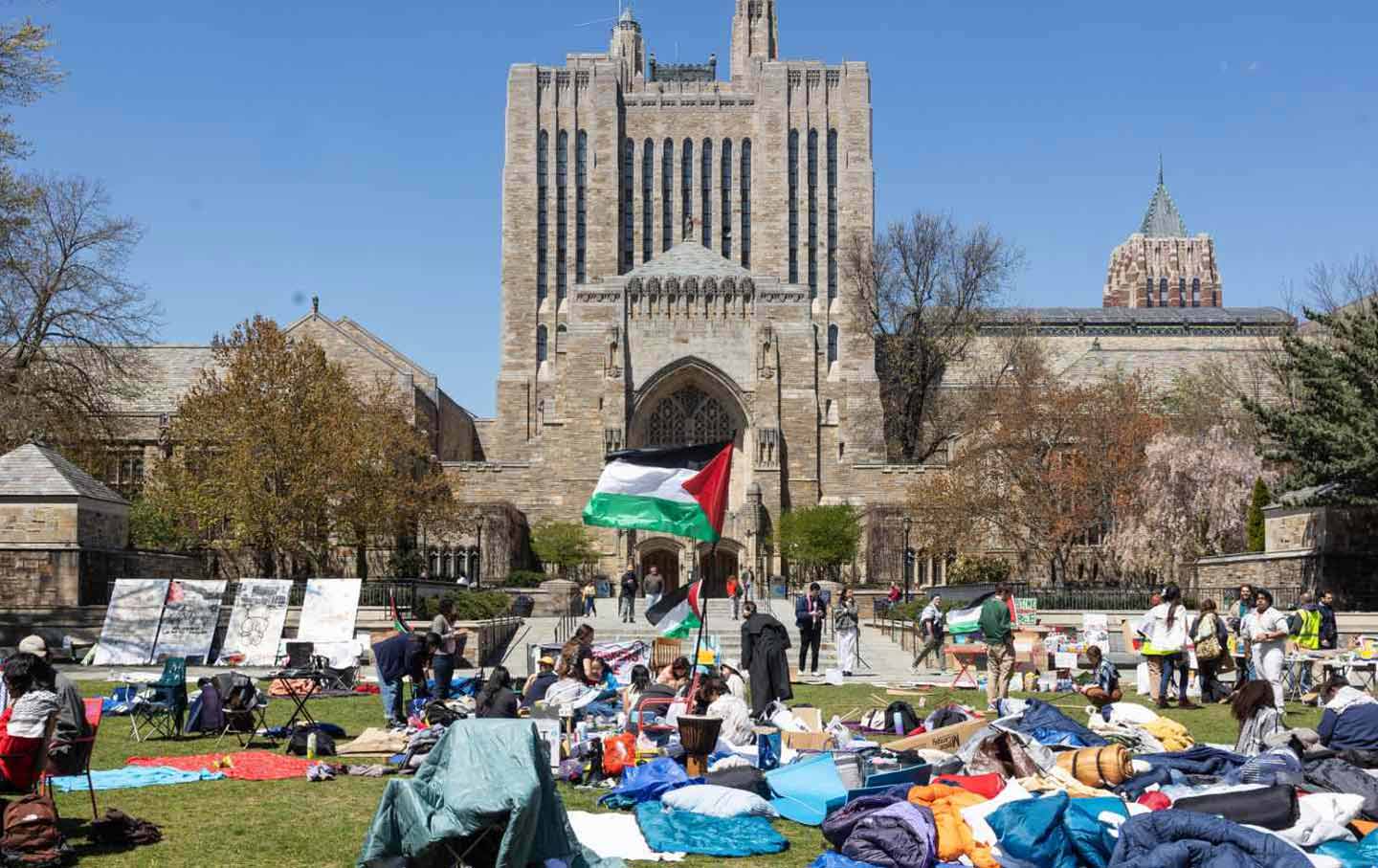
Yale Students Voted to Divest, but What’s Next is Unclear Yale Students Voted to Divest, but What’s Next is Unclear
The referendum calls on the school to divest its $41 billion endowment from military weapons manufacturing firms, yet the power to do so is in the hands of the board of trustees.
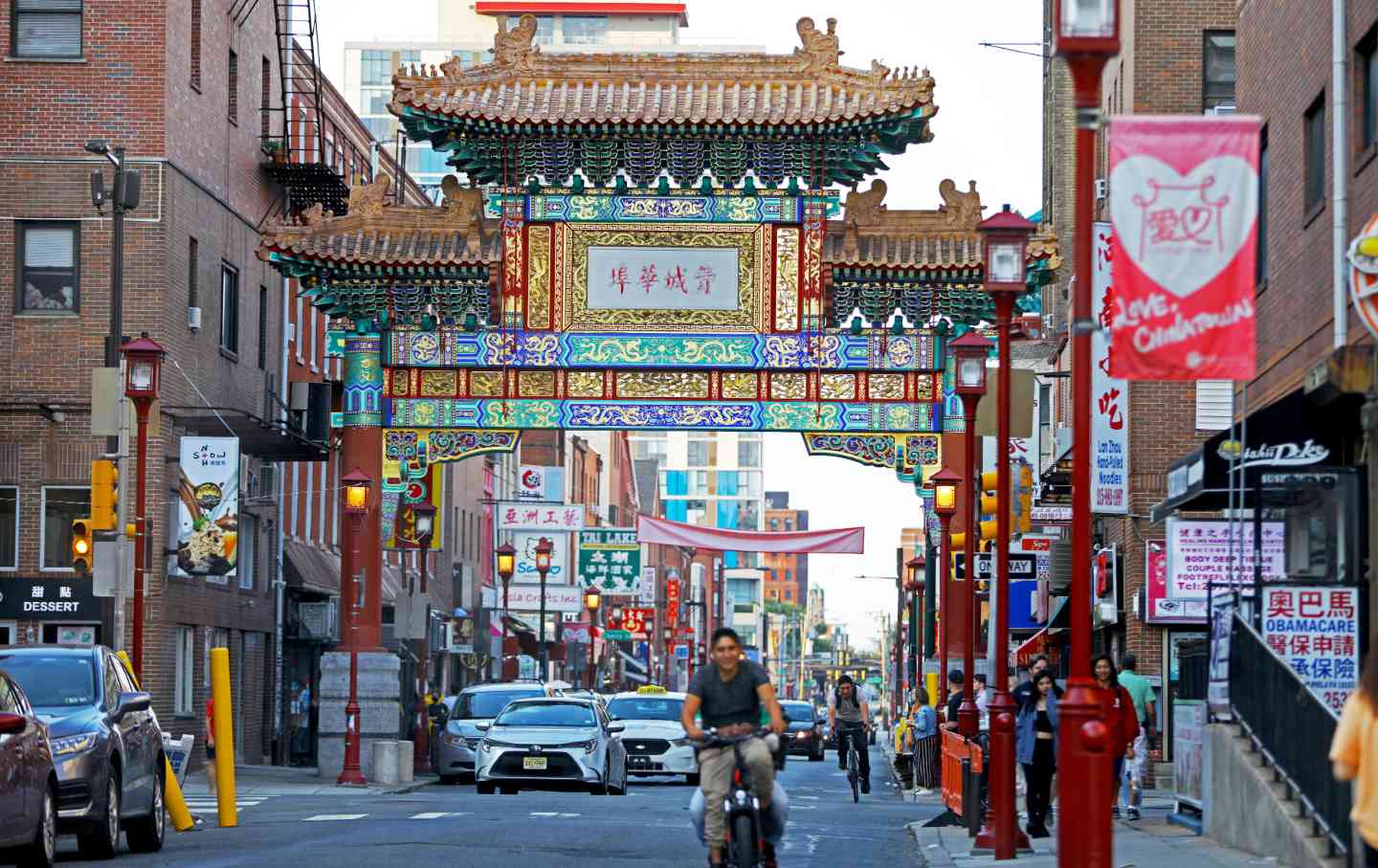
The “Save Chinatown” Coalition Goes on the Defensive in Philadelphia The “Save Chinatown” Coalition Goes on the Defensive in Philadelphia
The construction of a new basketball arena threatens to fill the neighborhood with more traffic and raise rents.
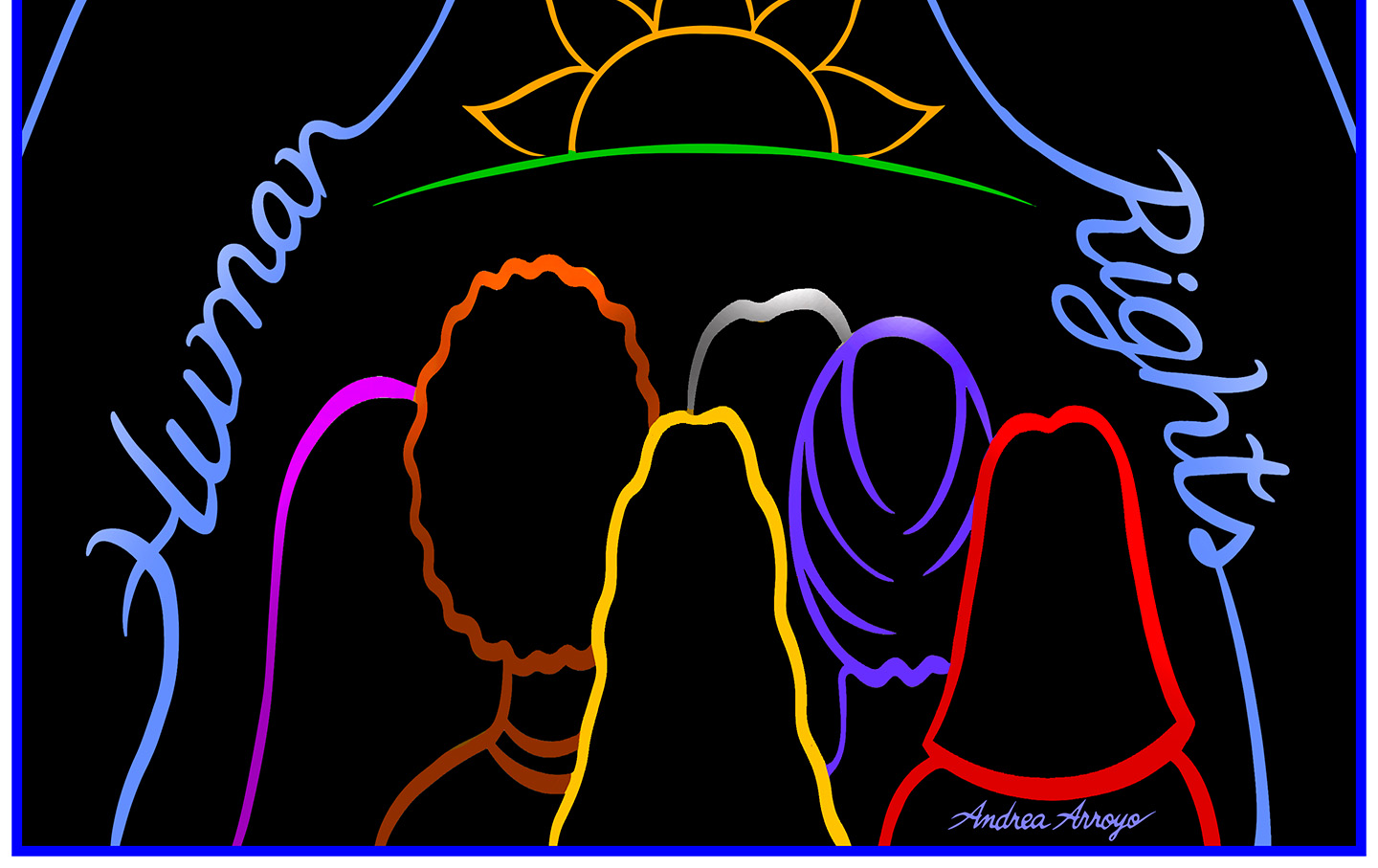
Human Rights for Everyone Human Rights for Everyone
December 10 is Human Rights Day, commemorating the anniversary of the Universal Declaration of Human Rights (UDHR), one of the world's most groundbreaking global pledges.
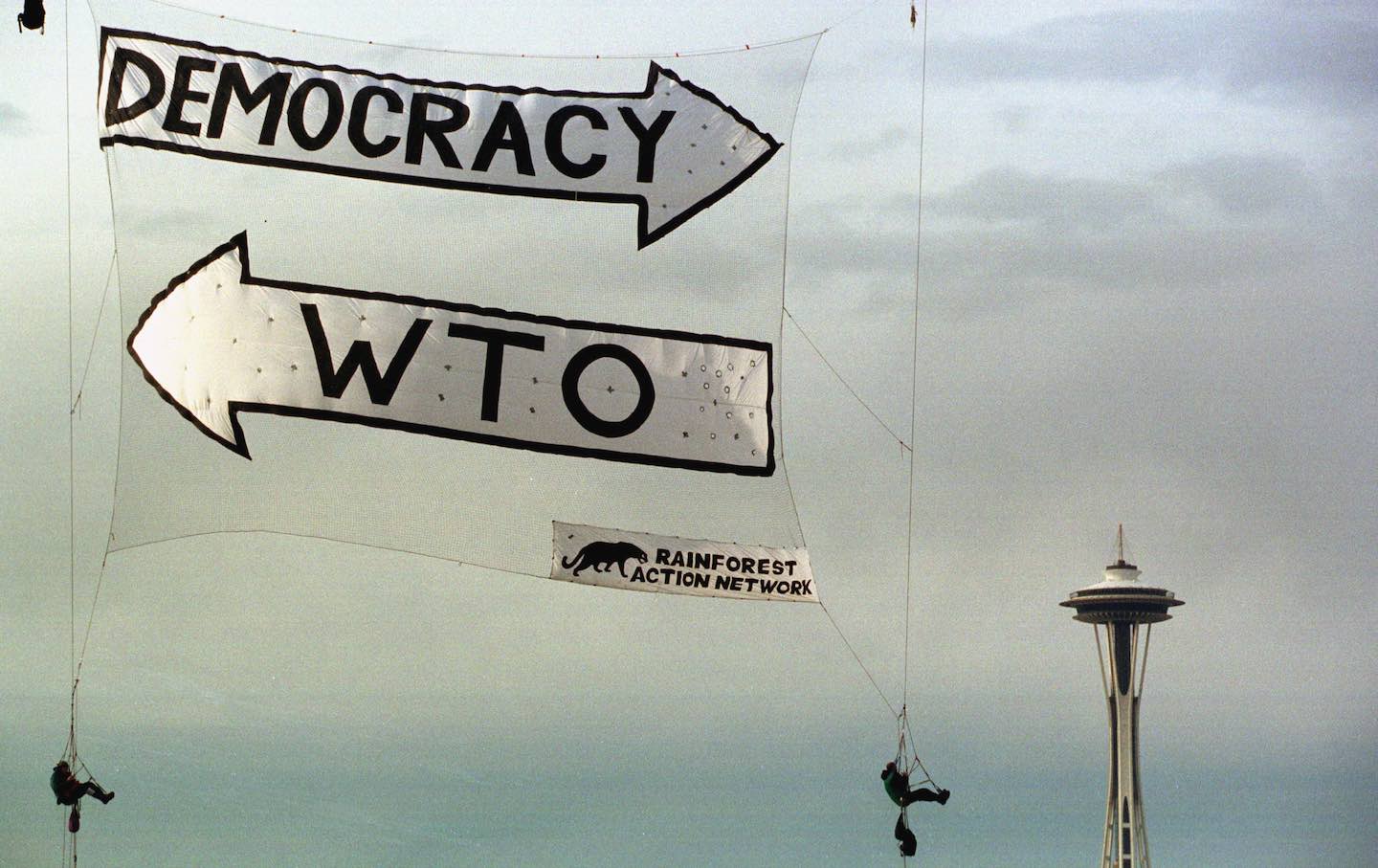
25 Years Ago, the Battle of Seattle Showed Us What Democracy Looks Like 25 Years Ago, the Battle of Seattle Showed Us What Democracy Looks Like
The protests against the WTO Conference in 1999 were short-lived. But their legacy has reverberated through American political life ever since.
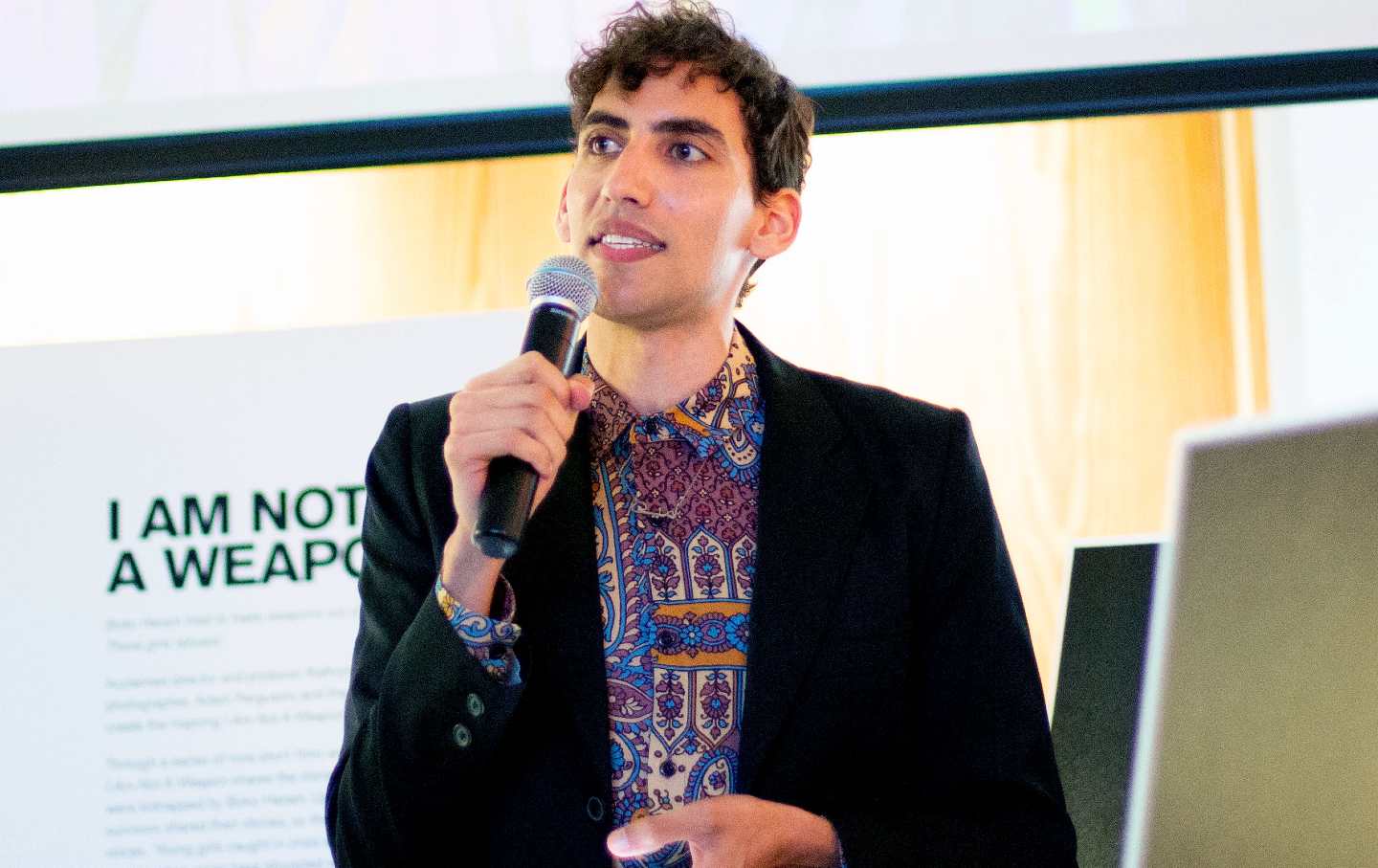
Hollywood’s Vocal Actors Union Goes Silent on a Gaza Ceasefire Hollywood’s Vocal Actors Union Goes Silent on a Gaza Ceasefire
Amin El Gamal, head of SAG-AFTRA's committee on Middle Eastern and North African members, has advocated for a statement supporting a ceasefire in Gaza—so far without success
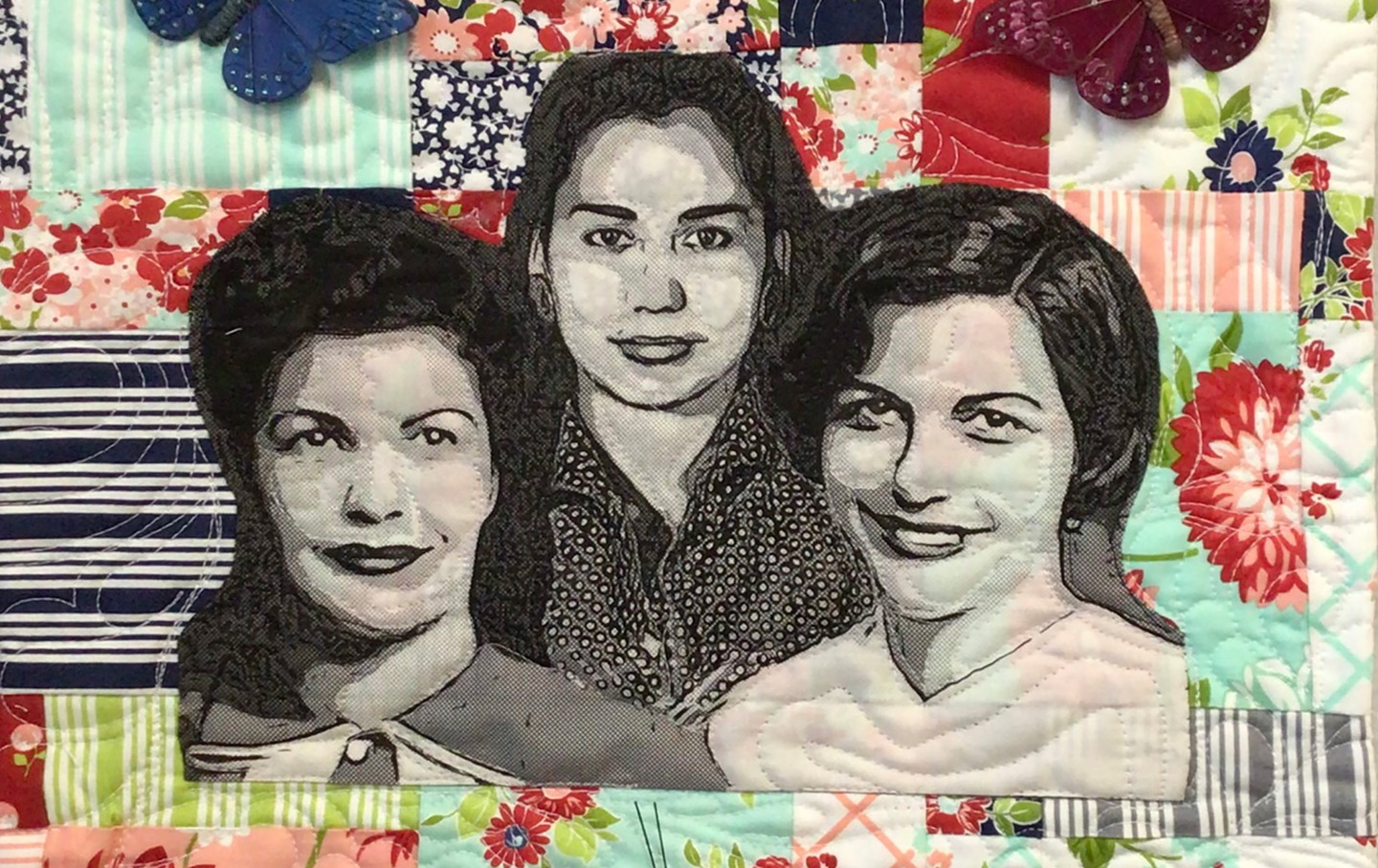
The Mirabal Sisters The Mirabal Sisters
Patria, Minerva, and María Teresa Mirabal were sisters from the Dominican Republic who opposed the dictatorship of Rafael Trujillo; they were assassinated on November 25, 1960, und...


